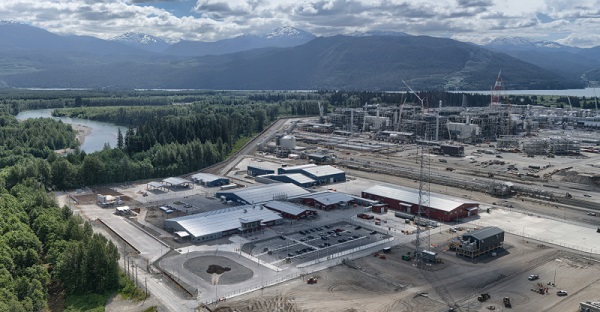Energy
We can and must adjust to climate change – and not kill billions

From the Frontier Centre for Public Policy
By Paul Driessen and Ronald Stein
The futures of poor developing countries hinge on their ability to harness foundational elements: fuels, electricity, minerals and feed stocks made from fossil fuels and other materials that are the basis for all buildings, infrastructures and other technologies in industrialized countries.
We’ve always done so and have no right to tell others they can’t have modern living standards.
Earth’s climate has changed many times over four billion years, and 99.999% of those changes occurred before humans were on this planet. During that short time, humans adjusted their housing, clothing and agriculture in response to climate changes. Can we now control the climate?
Except for decades-long droughts or massive volcanic explosions that ended some civilizations, humanity generally adjusted successfully – through a Pleistocene Ice Age, a Little Ice Age, a Dust Bowl and other natural crises. Numerous state high temperature records were set in Dust Bowl years.
After putting our current “microsecond” on Earth into its proper perspective, we might therefore ask:
* With today’s vastly superior technologies, why would humanity possibly be unable to adjust to even a few-degrees temperature increase, especially with more atmospheric carbon dioxide helping plants grow faster and better, providing more food for animals and people?
* How dare the political, bureaucratic, academic and media ruling elites – who propagate GIGO computer predictions, calculated myths and outright disinformation – tell us we must implement their “green” policies immediately and universally … or humanity won’t survive manmade climate influences that are minuscule compared to the planetary, solar and galactic forces that really control Earth’s climate?
* How dare those elites tell Earth’s poorest people and nations they have no right to seek energy, health and living standards akin to what developed countries already enjoy?
Scientists, geophysicists and engineers have yet to explain or prove what caused the slight change in global temperatures we are experiencing today – much less the huge fluctuations that brought five successive mile-high continental glaciers, and sea levels that plunged 400 feet each time (because seawater was turned to ice), interspersed with warm inter-glacial periods like the one we’re in now.
Moreover, none of the dire predictions of cataclysmic temperature increases, sea level rise, and more frequent and intense storms have actually occurred, despite decades of climate chaos fearmongering.
Earth continues to experience climate changes, from natural forces and/or human activity. However, adjusting to small temperature, sea level and precipitation changes would inflict far less harm on our planet’s eight billion people than would ridding the world of fossil fuels that provide 80% of our energy and myriad products that helped to nearly double human life expectancy over the past 200 years.
Today, with fuels, products, housing and infrastructures that didn’t even exist one or two centuries ago, we can adjust to almost anything.
When it’s cold, we heat insulated homes and wear appropriate winter clothing; when it’s hot, we use air conditioning and wear lighter clothing. When it rains, we remain dry inside or with umbrellas; when it snows, we stay warm indoors or ski, bobsled and build snowmen.
Climate changes may impact us in many ways. But eliminating coal, oil and natural gas – with no 24/7/365 substitutes to replace them – would be immoral and evil. It would bring extreme shortages of reliable, affordable, essential energy, and of over 6,000 essential products derived from fossil fuels.
It would inflict billions of needless deaths from diseases, malnutrition, extreme heat and cold, and wild weather – on a planet where the human population has grown from 1 billion to 8 billion since Col. Edwin Drake drilled the first oilwell in 1859.
* Weather-related fatalities have virtually disappeared, thanks to accurate forecasting, storm warnings, modern buildings, and medicines and other petroleum-based products that weren’t available even 100 years ago.
* Fossil fuels for huge long-range jets and merchant ships move people, products, food and medications to support global trade, mobility, health and lifestyle choices. Indeed, more than 50,000 merchant ships, 20,000 commercial aircraft and 50,000 military aircraft use fuels manufactured from crude oil.
* Food to feed Americans and humanity would be far less abundant and affordable without the fertilizers, insecticides, herbicides, and tractor and transportation fuels that come from oil and natural gas.
* Everything powered by electricity utilizes petroleum-based derivatives: wind turbine blades and nacelle covers, wire insulation, iPhone and computer housings, defibrillators, myriad EV components and more.
Petroleum industry history demonstrates that crude oil was virtually useless until it could be transformed in refineries and chemical plants into derivatives that are the foundation for plastics, solvents, medications and other products that support industries, health and living standards. The same is true for everything else that comes out of holes in the ground.
Plants and rocks, metals and minerals have no inherent value unless we learn how to cook them, extract metals from them, bend and shape them, or otherwise convert them into something we can use.
Similarly, the futures of poor developing countries hinge on their ability to harness foundational elements: fuels, electricity, minerals and feed stocks made from fossil fuels and other materials that are the basis for all buildings, infrastructures and other technologies in industrialized countries.
For the 80% of humanity in Africa, Asia and Latin America who still live on less than $10 a day – and the billions who still have little to no access to electricity – life is severely complicated and compromised by the hypocritical “green” agendas of wealthy country elites who have benefited so tremendously from fossil fuels since the modern industrial era began around 1850. Before that:
* Life spans were around 40 years, and people seldom travelled more than 100 miles from their birthplaces.
* There was no electricity, since generating, transmitting and utilizing this amazing energy resource requires technologies made from oil and natural gas derivatives.
* That meant the world had no modern transportation, hospitals, medicines and medical equipment, kitchen and laundry appliances, radio and other electronics, cell phones and other telecommunications, air and space travel, central heating and air conditioning, or year-round shipping and preservation of meats, fruits and vegetables, to name just a few things most of us just take for granted.
There are no silver-bullet solutions to save people from natural or man-made climate changes. However, adjusting to those fluctuations is the only solution that minimizes fatalities which would be caused by the callous or unthinking elimination of the petroleum fuels and building blocks that truly make life possible and enjoyable, instead of nasty, brutish and short. The late Steven Lyazi explained it perfectly:
“Wind and solar are … short-term solutions …. to meet basic needs until [faraway Ugandan villages] can be connected to transmission lines and a grid. Only in that way can we have modern homes, heating, lighting, cooking, refrigeration, offices, factories, schools, shops and hospitals – so that we can enjoy the same living standards people in industrialized countries do (and think is their right). We deserve the same rights and lives.
“What is an extra degree, or even two degrees, of warming in places like Africa? It’s already incredibly hot here, and people are used to it. What we Africans worry about and need to fix are malnutrition and starvation, the absence of electricity, and killer diseases like malaria, tuberculosis, sleeping sickness and HIV/AIDS…. We just need to be set free to [get the job done].”
Paul Driessen is senior policy analyst for the Committee For A Constructive Tomorrow (www.CFACT.org), and author of articles and books on environmental, climate and human rights issues.
Ronald Stein is an engineer, senior policy advisor on energy literacy for the Heartland Institute and CFACT, and co-author of the Pulitzer Prize-nominated book “Clean Energy Exploitations.”
Energy
CNN’s Shock Climate Polling Data Reinforces Trump’s Energy Agenda


From the Daily Caller News Foundation
As the Trump administration and Republican-controlled Congress move aggressively to roll back the climate alarm-driven energy policies of the Biden presidency, proponents of climate change theory have ramped up their scare tactics in hopes of shifting public opinion in their favor.
But CNN’s energetic polling analyst, the irrepressible Harry Enten, says those tactics aren’t working. Indeed, Enten points out the climate alarm messaging which has permeated every nook and cranny of American society for at least 25 years now has failed to move the public opinion needle even a smidgen since 2000.
Appearing on the cable channel’s “CNN News Central” program with host John Berman Thursday, Enten cited polling data showing that just 40% of U.S. citizens are “afraid” of climate change. That is the same percentage who gave a similar answer in 2000.
Dear Readers:
As a nonprofit, we are dependent on the generosity of our readers.
Please consider making a small donation of any amount here.
Thank you!
Enten’s own report is an example of this fealty. Saying the findings “kind of boggles the mind,” Enten emphasized the fact that, despite all the media hysteria that takes place in the wake of any weather disaster or wildfire, an even lower percentage of Americans are concerned such events might impact them personally.
“In 2006, it was 38%,” Enten says of the percentage who are even “sometimes worried” about being hit by a natural disaster, and adds, “Look at where we are now in 2025. It’s 32%, 38% to 32%. The number’s actually gone down.”
In terms of all adults who worry that a major disaster might hit their own hometown, Enten notes that just 17% admit to such a concern. Even among Democrats, whose party has been the major proponent of climate alarm theory in the U.S., the percentage is a paltry 27%.
While Enten and Berman both appear to be shocked by these findings, they really aren’t surprising. Enten himself notes that climate concerns have never been a driving issue in electoral politics in his conclusion, when Berman points out, “People might think it’s an issue, but clearly not a driving issue when people go to the polls.”
“That’s exactly right,” Enten says, adding, “They may worry about in the abstract, but when it comes to their own lives, they don’t worry.”
This reality of public opinion is a major reason why President Donald Trump and his key cabinet officials have felt free to mount their aggressive push to end any remaining notion that a government-subsidized ‘energy transition’ from oil, gas, and coal to renewables and electric vehicles is happening in the U.S. It is also a big reason why congressional Republicans included language in the One Big Beautiful Bill Act to phase out subsidies for those alternative energy technologies.
It is key to understand that the administration’s reprioritization of energy and climate policies goes well beyond just rolling back the Biden policies. EPA Administrator Lee Zeldin is working on plans to revoke the 2010 endangerment finding related to greenhouse gases which served as the foundation for most of the Obama climate agenda as well.
If that plan can survive the inevitable court challenges, then Trump’s ambitions will only accelerate. Last year’s elimination of the Chevron Deference by the Supreme Court increases the chances of that happening. Ultimately, by the end of 2028, it will be almost as if the Obama and Biden presidencies never happened.
The reality here is that, with such a low percentage of voters expressing concerns about any of this, Trump and congressional Republicans will pay little or no political price for moving in this direction. Thus, unless the polls change radically, the policy direction will remain the same.
David Blackmon is an energy writer and consultant based in Texas. He spent 40 years in the oil and gas business, where he specialized in public policy and communications.
Energy
LNG Export Marks Beginning Of Canadian Energy Independence

From the Frontier Centre for Public Policy
Kitimat’s LNG launch ends years of delay, weak policy and lost opportunity. This is a strategic turning point for Canada
Last week marked a turning point for Canadian sovereignty. On July 1, 2025, the tanker Gaslog Glasgow departed Kitimat, B.C., carrying Canada’s first-ever commercial liquefied natural gas (LNG) export to Asia. More than a shipment, it signalled the end of our economic vassalage to the United States and a long-overdue leap into global energy markets.
LNG Canada CEO Chris Cooper called it a “truly historic moment.” He’s right. The cargo left just days after the Kitimat plant produced its first liquefied natural gas and entered operation. The $40-billion megaproject, the largest private-sector investment in Canadian history, is now a fully functional Pacific Coast export hub. It can ship up to 14 million tonnes annually, and expansion is already being discussed.
Yet this success didn’t come easily. Despite being one of the world’s largest natural gas producers, Canada lacked an LNG export terminal, largely due to political delays, regulatory hurdles and lack of federal support. That this happened at all is remarkable, given nearly a decade of federal sabotage. Prime Minister Justin Trudeau’s ideological hostility to natural gas meant rebuffed allies, stalled projects and choked-off investment.
Foreign leaders (from Japan and Germany to Greece) practically begged Ottawa to green-light Canadian LNG. Trudeau dismissed them, claiming there was “no business case.” No one in his caucus dared contradict him. The result: lost time, lost markets and a near-complete surrender of our energy advantage.
But the business case was always there. Kitimat proves it.
The U.S. has been exporting LNG since 2016, giving them a nearly decade-long head start. But Canada has something our neighbours don’t: the Montney Formation. Spanning northeast B.C. and parts of Alberta, it covers about 130,000 square kilometres and holds enormous gas reserves. Montney gas, abundant and close to tidewater, trades at roughly half the Henry Hub price, giving Canada a significant cost edge.
Location seals the deal. Kitimat, perched on the Pacific, bypasses the congested Panama Canal, a major chokepoint for U.S. Gulf Coast exports, and offers a shorter, more direct route to energy-hungry Asian markets. This geographic advantage makes Canadian LNG not only viable but globally competitive.
In 2024, Canada exported about 8.6 billion cubic feet of gas daily to the U.S. via pipeline. With Kitimat, we finally begin breaking that one-market dependency. We also start clawing back the price differential losses that come with being captive sellers. This is how you build productivity, strengthen the dollar and reclaim economic independence from Washington.
The economic ripple effect is massive. The Kitimat build created 50,000 jobs at its peak, generated $5.8 billion in Indigenous and local contracts and left behind more than 300 permanent positions. Provincial revenues are projected in the tens of billions. In an era of anaemic growth, this is real stimulus and has staying power.
Predictably, critics raise environmental concerns. But this critique ignores global realities. Exporting Canadian natural gas to countries still burning coal is not a step backward—it’s a practical advance. Natural gas is up to 25 per cent cleaner than coal when comparing full lifecycle emissions (that is, from extraction to combustion). Global emissions don’t respect borders. If Canada can displace dirtier fuels abroad, we’re part of the solution, not the problem.
And this is only the beginning. Cedar LNG and Woodfibre LNG are already under construction. Atlantic Coast projects are in the queue. We must now defend this momentum against bureaucratic delays, activist litigation and ideological roadblocks.
LNG is not a climate villain. It’s a bridge fuel that cuts emissions, creates wealth and helps fund our national future.
Marco Navarro-Genie is vice-president of research at the Frontier Centre for Public Policy and co-author, with Barry Cooper, of Canada’s COVID: The Story of a Pandemic Moral Panic (2023).
-

 Fraser Institute1 day ago
Fraser Institute1 day agoBefore Trudeau average annual immigration was 617,800. Under Trudeau number skyrocketted to 1.4 million annually
-

 MAiD1 day ago
MAiD1 day agoCanada’s euthanasia regime is already killing the disabled. It’s about to get worse
-

 Frontier Centre for Public Policy1 day ago
Frontier Centre for Public Policy1 day agoNew Book Warns The Decline In Marriage Comes At A High Cost
-

 Business1 day ago
Business1 day agoPrime minister can make good on campaign promise by reforming Canada Health Act
-

 Addictions1 day ago
Addictions1 day ago‘Over and over until they die’: Drug crisis pushes first responders to the brink
-

 International1 day ago
International1 day agoChicago suburb purchases childhood home of Pope Leo XIV
-

 Daily Caller1 day ago
Daily Caller1 day agoUSAID Quietly Sent Thousands Of Viruses To Chinese Military-Linked Biolab
-

 Business2 days ago
Business2 days ago103 Conflicts and Counting Unprecedented Ethics Web of Prime Minister Mark Carney



